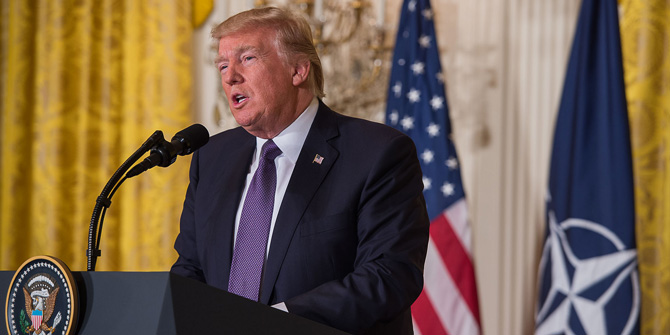
US Capitol Building (credit: Jonathon Colman)
Department of Government MSc Comparative Politics student Jack Graham gives his thoughts on the imminent US election and explains why there is more to it than Trump and Clinton.
The down-ballot races
Thanks to the seemingly endless ugly spectacle of the 2016 election, you’d be forgiven for thinking that the presidency consists of a celebrity sat in an oval-shaped office, dishing out one-liners to TV networks. American democracy has been dragged through the dirt, largely thanks to a certain property mogul, while aided and abetted by an irresponsible news media feeding off his every scrap.
My intention today is not to soil the LSE Government Blog with more sordid stories, which have regrettably dominated election coverage, but turn our attention instead towards a hugely important, yet frequently overlooked, element of the vote on November 8th: the down-ballot races.
Americans are not just choosing their president, but deciding who will be representing them in the House of Representatives and the Senate. Following six years of gridlock in Congress under President Barack Obama, a great deal is at stake. Whether Clinton staggers over the line or Trump pulls off an upset, the makeup of the Capitol will help determine the next president’s scope for change.
The divided Obama years
Divided government necessitates cross-party cooperation to get things done. Unfortunately, the past few years have been characterised by hyper-partisanship and stalemate. With a blue Congress in his first two years, Obama’s administration pushed through a substantial list of policies, from the economic stimulus and Dodd-Frank Wall Street reform to the Affordable Care Act (‘Obamacare’). In 2010, though, Republicans regained the House in a landslide, and won the Senate back four years later.
Numerous legislative battles have raged on with no definite conclusion, leaving a number of issues unresolved. Obamacare has been particularly divisive, with Republicans in Congress attempting to repeal the act dozens of times, and Democrats powerless to iron out its faults. Meanwhile, on many issues, most notably gun control and immigration reform, the President has been forced to resort to executive action: orders which are fragile without Congressional approval.
Obama’s message in 2008 was to look towards an era of ‘post-partisan’ politics, but when his successor is inaugurated in January (s)he will face a legislative branch as divided as ever. The key question will be whether the Democrats can restore a balance of power on Capitol Hill by winning back the Senate. For the Republicans, it’s all about conserving their hard-fought mid-term gains.
The race to take over the Senate could be extremely close
This year, 34 seats are up for grabs, including 24 held by the GOP. The Democrats need to gain four seats to take control if Clinton wins the presidency, and five seats if Trump wins (the Vice President has a vote in the event of a tie). Around a dozen seats could go either way. Democratic candidates look likely to make gains in the mid-West, with leads in Illinois, Wisconsin and Indiana. However, former presidential candidate Senator Marco Rubio has held his ground in Florida, while the GOP are eyeing up Nevada, the seat from which Minority Leader Harry Reid is retiring.
Meanwhile, the best Democrats can hope for in the House is to weaken GOP control.
The Republican majority in the House – 247 to the Democrats’ 188 – is the largest they’ve had since the late 1920s. Over the past two decades, Democrats have only held a majority for four years, despite holding control for the 40 years beforehand. Unlike the Senate, all 435 seats are up for election on November 8th. In order to wrest control from the GOP, therefore, the Democratic Party would need to win 30 seats, which is highly unlikely.
Splits within the Republican Party
One of the things that makes this election year so distinct is the deep split within the Republican Party. The Senate and House Majority Leaders, Senator Mitch McConnell and Representative Paul Ryan respectively, have tried to retain control of the party and its agenda as separate from their presidential nominee. For the past six months, Ryan has been laying out his conservative vision and policy agenda for the House, trying wherever possible to avoid talk of Trump. Staggeringly, during his 1,450-word convention speech in July, he mentioned their candidate’s name just twice. While both McConnell and Ryan were forced to give him their lukewarm endorsements, they have condemned Trump’s indefensible comments and kept him at arm’s length.
But the presidential race and votes for Congress do not occur in isolation; the former plays a crucial role in determining results in both the House and Senate. This has been a constant concern for the GOP leadership, worried that their chances of maintaining their healthy majorities are being dragged down by Trump. Congressional Republicans have been stuck between a rock and a hard place, wanting to avoid damage from Trump’s antics, yet wary of alienating their base by rejecting him. In the past few weeks, as Clinton built her strong lead (before FBI Director James Comey’s email stunt which has seen the polls tighten), GOP ‘super PAC’ campaign money has increasingly abandoned Trump to focus on Congressional races, with adverts imploring voters to check Clinton’s power by backing Republican members of Congress.
Readying themselves for the likely event of a Clinton presidency, Republicans are focussed on damage limitation to cling onto their control of Capitol Hill. The Democrats have a real chance of winning the Senate, while weakening the GOP majority in the House is of paramount importance to restricting Paul Ryan’s power.
In a week’s time Americans will be making one of the biggest political decisions of their lives. Remember, though, it’s not all about Trump and Clinton.
Jack Graham is an MSc Comparative Politics student in the LSE Department of Government. He also commentates on CapX, Sky News and talkRADIO on American politics and has his own blog: https://anarrowatlantic.wordpress.com/.
Follow Jack on Twitter – @jacktgraham

Note: this article gives the views of the author, and not the position of the LSE Department of Government, nor of the London School of Economics.





